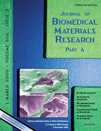Mesenchymal stem cell-seeded collagen matrices for bone repair: Effects of cyclic tensile strain, cell density, and media conditions on matrix contraction in vitro
Abstract
Type I collagen is the most abundant extracellular matrix protein in bone and contains arginine– glycine–aspartic acid sequences that promote cell adhesion and proliferation. We have previously shown that human mesenchymal stem cells (hMSCs) seeded in three-dimensional (3D) collagen gels upregulate BMP-2 mRNA expression in response to tensile strain, indicative of osteogenesis. Therefore, collagen could be a promising scaffold material for functional bone tissue engineering using hMSCs. However, high contraction of the collagen gels by hMSCs poses a challenge to creating large, tissue-engineered bone constructs. The effects of cyclic tensile strain, medium (with and without dexamethasone), and hMSC seeding density on contraction of collagen matrices have not been investigated. hMSCs were seeded in 3D collagen gels and subjected to cyclic tensile strain of 10% or 12% for 4 h/day at a frequency of 1 Hz in osteogenic-differentiating or complete MSC growth media for up to 14 days. Viability of hMSCs was not affected by strain or media conditions. While initial seeding density affected matrix contraction alone, there was a high interdependence of strain and medium on matrix contraction. These findings suggest a correlation between hMSC proliferation and osteogenic differentiation on collagen matrix contraction that is affected by media, cell-seeding density, and cyclic tensile strain. It is vital to understand the effects of culture conditions on collagen matrix contraction by hMSCs in order to consider hMSC-seeded collagen constructs for functional bone tissue engineering in vitro. © 2008 Wiley Periodicals, Inc. J Biomed Mater Res, 2009




